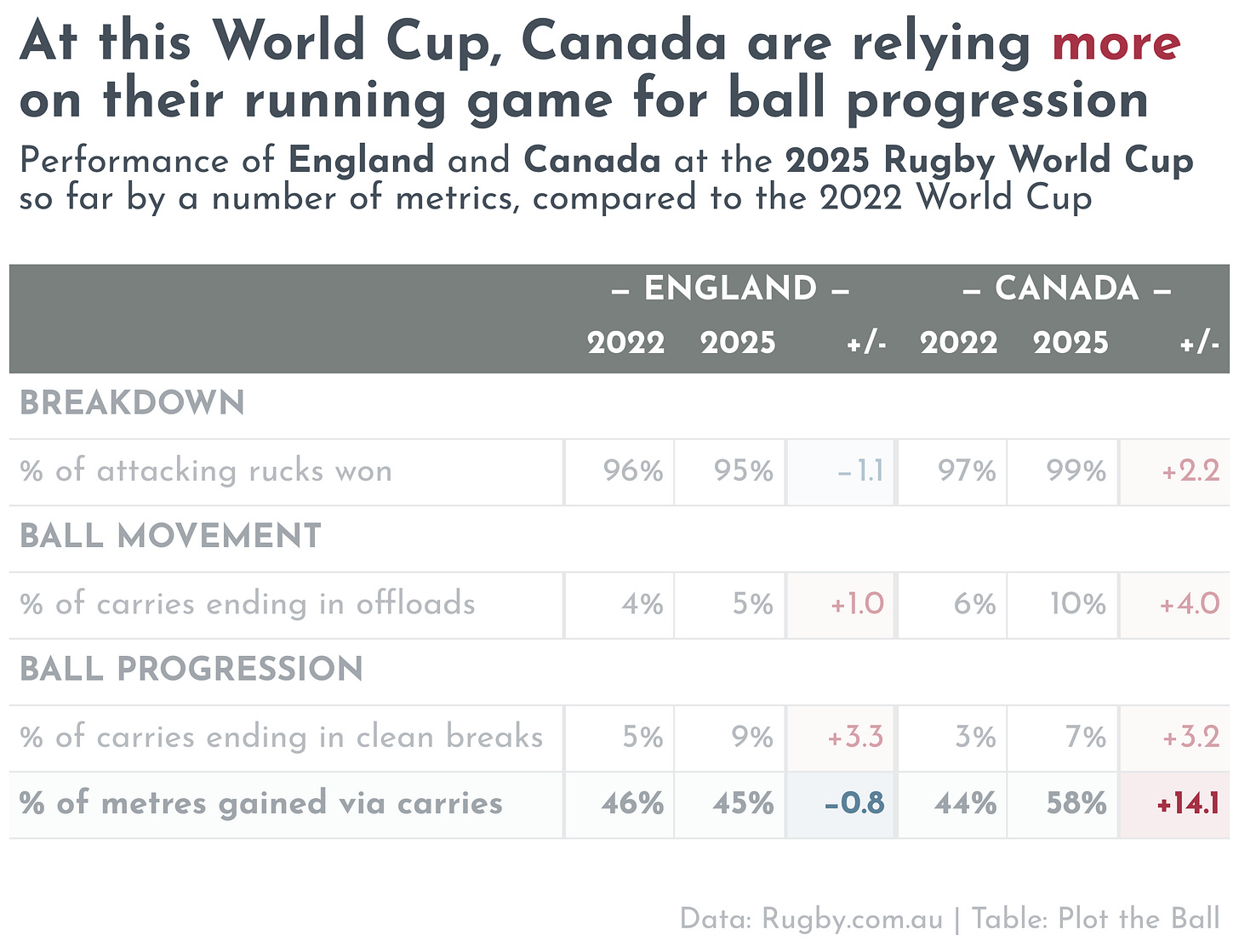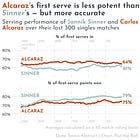⚾️ With the Dodgers, Shohei Ohtani is throwing harder — and pitching better — than ever before
My Week in Sport(s) ⚾️ 🏉 🏏 🏀 ⚽
Welcome to My Week in Sport(s) — a regular newsletter from Plot the Ball.
Covered in this edition: ⚾️ Shohei Ohtani, 🏉 Canada, 🏏 Abhishek Sharma, 🏀 the Indiana Fever and ⚽ Erling Haaland.
⚾️ With the Dodgers, Shohei Ohtani is throwing harder — and pitching better — than ever before
Pitchers — especially those who throw hard — must be handled with care. In the case of baseball’s only two-way superstar, Shohei Ohtani, even more caution is required: there is so much more to his game than pitching that you don’t want to jeopardise.
As he recovered from another elbow ligament injury, Ohtani played exclusively as a designated hitter in his first season with the Los Angeles Dodgers. Fully fit again this year, the team — with an eye on a trip back to the World Series — have very gradually dialled up his pitching. He didn’t take the mound in a major-league game until June, didn’t throw more than 50 pitches in a single start until the end of July and only completed more than five innings in an outing for the first time earlier this week.
As the postseason approaches, it appears that the Dodgers have stuck the landing: Ohtani has remained a dominant presence in their batting line-up over the second half of the season, but he’s also become an integral part of their pitching rotation. Remarkably, he might actually be an even better pitcher than he was before his latest elbow injury. For one, he’s throwing harder than ever before: the average velocity of his four-seam fastball is above 98 mph for the first time in his career.
Ohtani’s underlying performance has also been excellent. He is striking out more batters than he did in an Angels uniform, while also allowing fewer walks and giving up fewer ‘hard-hit’ batted balls. When I wrote about his Japanese teammate Roki Sasaki at the beginning of the season, I mentioned the Dodgers’ lauded player-development environment as one factor in his choice to sign a contract with the franchise. There’s no reason why Ohtani wouldn’t also be benefitting from it.
His velocity boost follows one clear tweak he’s made with the Dodgers: he’s pitching out of a full wind-up again, having favoured an abbreviated delivery with the Angels. As for Sasaki: after struggling with his fastball to start the year, he’s back throwing hard in the majors; his return to form might well be due to the franchise’s mechanical tinkering, too. The Dodgers’ handling of two of their prize assets has been impressive — and evidence that caution doesn’t have to come at the expense of development.
🏉 Canada have earned their place in the Rugby World Cup final by excelling with ball in hand
I’ve been surprised to see Canada’s win over the Black Ferns in the Rugby World Cup semi-final last week described as an ‘upset’. In the teams’ last two matches head to head — both of which were in New Zealand — they managed one win and one draw.
Regardless, their run to the final has been a fairytale. Unlike other top nations, most of their squad is based overseas — and they have had to rely on crowdfunding to top up the money they receive from their own governing body. After a creditable fourth-place finish at the last World Cup, the Canadians have evolved their attacking play, too. Their ball retention at the breakdown was already excellent — but they have managed to improve the share of attacking rucks they win by another 2.2 percentage points.
They’ve also added more of an offloading game. 10% of their carries at this World Cup have resulted in a completed offload, compared to just 6% at the last tournament in 2022; this has helped them break the line much more frequently. Of the two teams in tomorrow’s final, it’s Canada — and not favourites England — who are more reliant on their running game to progress the ball upfield: 58% of their metres gained this tournament have come from carries, compared to England’s 45% share.
What else I learned last week
🏏 No other T20I opener has ever scored as quickly as Abhishek Sharma
India’s dominance of men’s T20 International cricket is pretty astonishing. Since the format was introduced in 2005, they have won 2.3 times as many matches against the sport’s other top nations as they’ve lost; the next-best team by this metric is at 1.3x.
Unsurprisingly, they have been far better than every other team so far at the 2025 Asia Cup — and left-handed opening batter Abhishek Sharma has cemented himself as their new star. In the history of the T20I format, 81 opening batters from test-playing nations have faced at least 360 career deliveries. Abhishek’s strike rate is 60 runs per 100 balls better than the other openers in the matches that he’s played; among the 80 others in this cohort, the highest mark is 36 runs above expectation.
🏀 The Fever improved a lot this season — even without Caitlin Clark
It’s fair to say that this hasn’t been the year anyone expected for the Indiana Fever: they are still alive in the second round of the WNBA playoffs, despite their most important player having missed three quarters of the regular season with injury.
While they weren’t on a consistent upward trajectory, the Fever’s performances did improve over the course of Caitlin Clark’s first season in the league. Even without Clark, the team did manage to step up another level in 2025: their average scoring margin was +3.4 points per game this regular season, much better than their mark of -2.7 a year earlier. This doesn’t lead me to question Clark’s impact, though: as in 2024, the team were several points better per 100 possessions with her on the court.
⚽ Erling Haaland is taking even better shots despite a heavier workload
As Mike Goodman — of the excellent Double Pivot podcast — highlighted last week, the attacking workload that Erling Haaland has borne for Manchester City this season is beyond anything we’ve seen in the recent history of the Premier League.
The Norwegian international is in his seventh season in a top European league, and has never taken more shots than the 4.6 per 90 minutes he is averaging so far in 2025-26. This increase in volume hasn’t been accompanied by a deterioration in quality, though. Haaland’s average non-penalty shot has been worth 0.30 expected goals so far this season — in the same ballpark as his best year at Dortmund, and comfortably ahead of his previous seasons in the Premier League with City.
The next edition of My Week in Sport(s) will be published in two weeks, on Friday October 10th.





